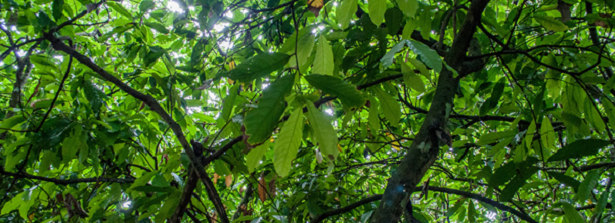The importance of an early reality check – Asking cocoa farmers about pruning

Ambra Tosto is a PhD Candidate at Wageningen University and Research working on the NWO Global Challenges Programme (GCP) project called “Cocoa crop improvement, farms and markets: a science-based approach to sustainably improving farmer food security in West Africa”. She has written this Story of change following the GCP training on November 1, 2017, facilitated by Perspectivity.
Pruning
Pruning is the “art and science of cutting away a portion of a tree for horticultural purposes”. It is an essential practice for many commercial tree crops. In this way we can shape and guide the plant development, balance fruit production, facilitate plant harvest and ensure a good light penetration in the interior of the tree.
Since pruning is an art, it requires trained skills. Since it is a science, it requires a good understanding of the plant we want to prune. Crops as apple, olive and grape have a long tradition of pruning, and experimental trials, to back up tradition with data, started in the early 20th century.
Cocoa is different
For cocoa, one of the most important tree crops in tropical areas, the story seems to be a bit different. In West Africa cocoa represents the main source of income for millions of farmers. But management practises are often inadequate and yield is low.
Pruning is often minimal. The results are: very tall cocoa trees that are difficult to harvest, little light penetration in the canopy and high impact of fungal diseases due to little air circulation.
This is what I could retrieve from literature, in this first phase of my PhD that aims to provide scientific support to the design of effective pruning practises for cacao farmers in West Africa.
“I closed my eyes”
During the kick-off meeting of the project, that was held in Ivory Coast, we had the opportunity to visit a cocoa farmer involved in a fertilizer trial of the national centre for agronomic research (CNRA). Technicians and researchers from CNRA had pruned his trees in preparation for the fertilizer application, then applied the fertilizer and marked the different treatments. While guiding us through the cocoa field, the farmer recalled the moment the technicians came and said: “When they came to prune, I closed my eyes not to see what they were doing to the trees.”
Few days later I was in Ghana, visiting potential farms for data collection. The owner of a beautiful example of cocoa agroforestry, an old farmer with many years of experience, gave me a similar answer when asked about pruning.
Two isolated voices are surely not the objective representation of a region, but what they said really struck me. After all, I thought, pruning practises do not seem so attractive for farmers.
A call for collaboration
Coming from a culture where it is impossible to imagine commercial fruit production without pruning, I didn’t consider this possibility before. This resulted in a very fundamental question: Would scientific based pruning practise have an impact when most farmers do not want to prune at all?
This realization adds a new dimension to my project and calls for a closer collaboration with the social science colleagues that are involved in the project. We decided that together we will design a survey to gain insight in the practices and opinions of the farmers.
A better understanding of the perception that farmers have of pruning, and of the economic constraints that they face in this regard, would surely help in designing pruning recommendations that would be much closer to their needs.
_ _ _
Written by Ambra Tosto, PhD Candidate at Wageningen University and Research.






